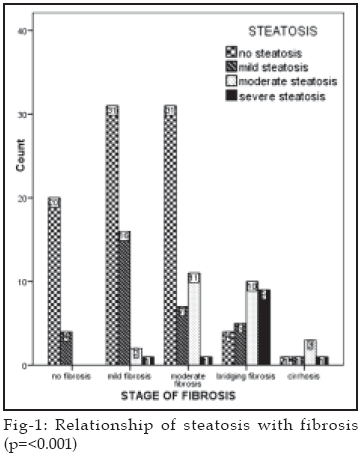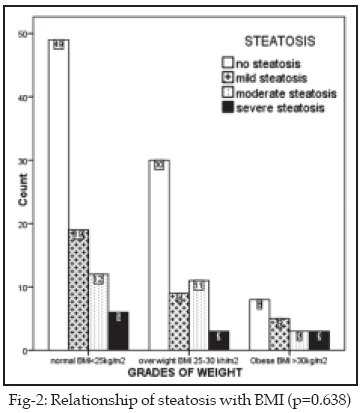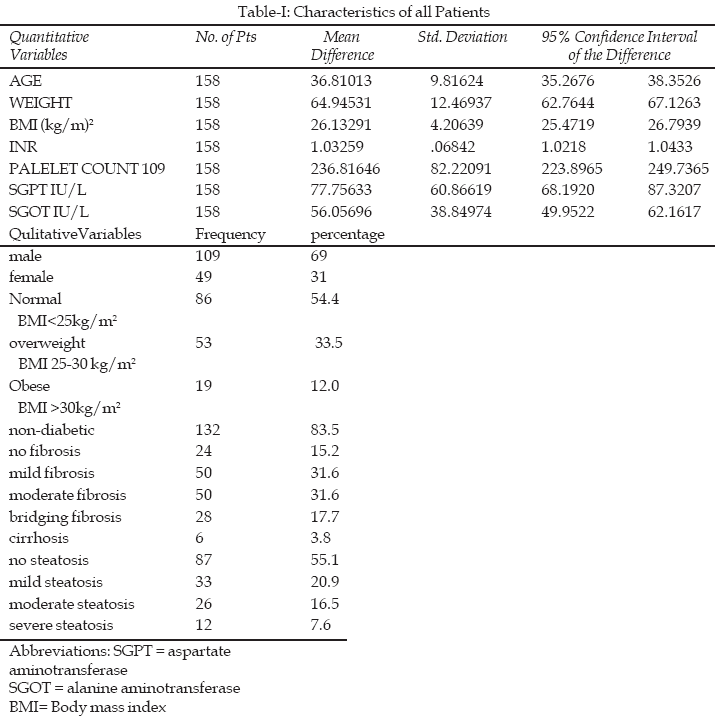|
 |
|
Published
by : PROFESSIONAL MEDICAL PUBLICATIONS |
|
ISSN 1681-715X |
|
|
|
|
|
- |
|
ORIGINAL
ARTICLE |
|
- |
|
Volume 25 |
April
- June 2009 (Part-I) |
Number 2 |
|
|
|
Frequency of steatosis and its relation with the
grade of fibrosis in patients with Hepatitis C
Samiullah Shaikh1, Memon Sadik2,
Baloch Ghulam Hussain3
ABSTRACT
Objective: To study the frequency of
steatosis and observe the relation between steatosis and grade of fibrosis in
patients with hepatitis C.
Methodology: This descriptive case series study was
undertaken at Liaquat University of Medical & Health Sciences hospital from
July 2005 to November 2007. It included 158 PCR-positive hepatitis C cases
with genotype 3. Patients demographic data was enrolled in well designed
proforma BMI was calculated and history of diabetes mellitus was obtained.
Liver biopsy was done after written consent and was sent for grading of
fibrosis and steatosis. T-test was applied for Continuous variables whereas
stage of fibrosis was compared with grade of steatosis, BMI and age by
chi-square test. 0.05 was made a level of Significance.
Results: This study included 158 patients out of
which 109 (69%) were male and 49(31%) were female. The mean age of the patient
was 36.8± 9.8.The BMI was <25 in 86(54.4%) whereas BMI 25-30 was present in53
(33.5%) and BMI >30 in 19 (12%) of cases. The steatosis was found in 71(45%)
of cases. Mild (<30% of hepatocytes involved) 33(21%), moderate (30-60%
hepatocytes involved) in 26 (16.5%) and severe (>60% hepatocytes involved)
steatosis in 12(7.5%) cases. A strong correlation between steatosis score and
fibrosis stage was observed in our study (P= < 0.001) whereas no relationship
was observed between BMI (P = 0.67) or age (P =0.39) with stage of steatosis.
Conclusion: This study showed that increased
steatosis is associated with worsening fibrosis suggesting a possible role for
steatosis in the acceleration of liver disease in HCV Patients and efforts to
control steatosis may therefore have an important role in halting HCV liver
disease progression.
KEYWORDS:
Steatosis,
Fibrosis, Hepatitis C, PCR, BMI.
Pak J Med Sci April - June 2009
Vol. 25 No. 2 283-288
How to cite this article:
Shaikh S, Sadik M, Hussain BG. Frequency of steatosis and its relation with
the grade of fibrosis in patients with hepatitis C. Pak J Med Sci
2009;25(2):283-288
1. Samiullah Shaikh, FCPS
Assistant Professor,
2. Memon Sadik, FCPS (Medicine),
FCPS (Gastroenterology)
Associate Professor,
Department of Medicine,
Isra University Hospital,
Hyderabad - Sindh,
Pakistan.
3. Baloch Ghulam Hussain, MD
Senior Lecturer,
1,3: Department of Medicine,
Liaquat University of Medical &
Health Sciences, Jamshoro /
Hyderabad - Sindh,
Pakistan.
Correspondence
Dr. Samiullah Shaikh
Assistant Professor
Department of Medicine
Liaquat University of Medical &
Health Sciences, Jamshoro /
Hyderabad - Pakistan.
Email: shaikh135@hotmail.com
shaikhsamiullah@yahoo.com
* Received for Publication: September 16, 2008
* Revision Received: February 11, 2009
* Revision Accepted: February 13, 2009
INTRODUCTION
Hepatitis C virus is a major cause of chronic liver disease
with about 170 million people infected worldwide.
1
The severity of disease varies widely from asymptomatic
chronic infection to cirrhosis and
hepatocellular carcinoma.
1
Although most HCV associated liver damage is immunomediated,2
some histopathological features, such as liver steatosis, suggest a viral
cytopathic effect.3
Several observations indicate that steatosis may be
directly due to HCV: its association with genotype 3,
4
correlation between its severity and level of HCV replication,5
and its disappearance on response to antiviral therapy.6
However, some data suggest that the pathogenesis of mild steatosis of most HCV
infected patients may be metabolic as its severity correlates with body mass
index (BMI)7
whereas only the moderate to severe steatosis typically found in patients with
genotype 3 may be HCV related. 7
Thus steatosis observed in chronic hepatitis C is not always virally related
as other factors may coexist. This is not surprising considering the frequency
of liver steatosis in the general population (15%).8
A major question concerns the
impact of steatosis on liver disease progression, as suggested by some
authors.9
Cohort studies on patients with non-alcoholic fatty liver
disease show that simple steatosis runs a benign nonprogressive clinical
course.
10
However, steatosis in chronic hepatitis C is almost invariably accompanied by
some degree of necroinflammation. Thus steatosis may contribute to liver
disease progression either directly or via a synergistic effect with
inflammation or other cofactors.
Our aim in this study was to determine the frequency of
steatosis in patients with hepatitis C and to explore the relation between
steatosis and other risk factors for steatosis such as BMI and age with
steatosis in patients with hepatitis C.
METHODOLOGY
Study population: This study included 158 consecutive,
Anti HCV ,HCV RNA positive, and genotype 3 patients admitted in Liaquat
University Hospital Jamshoro/Hyderabad between July 2005 and March
2007.Patients with HCV genotypes except genotype3, active Liver disease
related to hepatitis B virus, stigmata of autoimmune liver disease (as defined
by international criteria),
11
patients with hyperlipidemia: total cholesterol and/or triglycerides >200
mg/dL; alcoholism (ingestion of >40g ethanol per day for men and >20g ethanol
per day for women);diabetes mellitus: fasting glycemia >126mg/dL8
and/or use of oral hypoglycemics
or insulin; and use of potential steatosis-inducing drugs such as
corticosteroids, estrogen, amiodarone, nifedipine or diltiazem during the 6
months preceding the liver biopsy were excluded from the study.12
This study was conducted in conformity with the Helsinki
declaration and all patients consented to participate.
All patients fulfilling the above criteria were studied to
assess the relationship between steatosis and fibrosis. The following data
were entered on a clinical database: age, gender, height, weight, presence or
absence of diabetes, and BMI (kg/height in meters
2).
Blood samples for liver functions test, prothrombin time, Protein profile,
blood glucose, lipid profile, blood complete blood picture with platelet count
were collected before the biopsy. Liver biopsy was performed under local
anesthesia by a well trained person. A Tru-cut needle (14-gauge) was used and
the procedure was conducted under ultrasound guidance. An adequate biopsy
sample defined as specimen size greater than 10mm and more than 5 portal
tracts was obtained in all patients.
13 .No major complications such
as requirement of blood transfusion, hypotension or biliary peritonitis were
observed. A single well qualified histopathologist who was unaware about the
clinical data assessed the biopsy slides.
The degree of hepatic fibrosis was staged according to
Metavir fibrosis score as: F0= no fibrosis; F1= fibrous portal expansion; F2=
fibrous bridging fibrosis (portal–portal or portal–central linkage); F3=
bridging fibrosis with lobular distortion(disorganization); and F4= cirrhosis.
14
The severity of steatosis was
graded as 0 or absent (<1% of total hepatocytes), 1 or mild (between 1% and
30% of hepatocytes), 2 or moderate (between 30% and 60% of hepatocytes), and 3
or severe (>60% of hepatocytes).15
The patients were divided into three categories with category one having BMI
<25(kg/m2) ,category two with BMI 25-30(kg/m2) and category three with BMI
>30(kg/m2).16
Statistical procedure: Descriptive statistics are
provided as means ± 1 SD. The t-test was used to compare quantitative data,
and the chi-square test was used for categorical data. P-values <0.05 were
considered significant. All analyses were carried out using SPSS version 16
software (SPSS, Inc, Chicago, IL).
RESULTS
This study included 158 patients out of which 109 (69%)
were male and 49(31%) were female. The mean age of the patients was 36.8±9.8.
The Body mass index (BMI) of 86 (54.4%) patients was<25kg/m
2
whereas BMI of 53(33.5%) was between 25-30kg/m2
and 19 (12%) patients had BMI >30kg/m2.
Liver biopsy showed stage 0 fibrosis (F0) in 24(15.2%) stage one fibrosis (F1)
in 50(31.6%),stage two (F2) in 50(31.6%), stage three (F3) in28 (17.7%) and
stage four (F4) in 6 (3.9%) patients. On histological assessment steatosis was
present in 71/158 (45%) of cases of which mild Steatosis was found in
33(20.9%), moderate steatosis in 26 (16.5%) and severe steatosis in 12(7.6%)
cases. Table-I shows the characteristics of all patients. A strong correlation
between steatosis score and fibrosis stage was observed in our study (P=
<0.001) as shown in Fig.1 which describe that as the fibrosis progressed so as
the steatosis.

The patients with BMI
<25 kg/m2
37/71 had mild to severe steatosis, 23
/71 overweight patients with BMI 25-30kg/m2
had mild to severe steatosis whereas 11/71 obese patients with BMI >30kg /m2
had mild to severe steatosis. A
poor relationship was observed between steatosis and BMI (P= 0.67) as shown in
Fig-2. A nonsignificant relationship was found between age (P =0.39) with
grade of steatosis.

DISCUSSION
In this study, steatosis was present in 45% liver biopsies
of patients with hepatitis C. This figure is near to the results of the J
Wyatt
11
who has seen steatosis in 50% of biopsies. According to Zahid et al. who
studied 76 patients with Hepatitis-C and found steatosis in 67.5% of cases.17
In a recently published study by Alia Zubair steatosis was present in 46% of
biopsies in 100 patients with Hepatitis-C.18
We found a highly significant association between steatosis and stage of
fibrosis, as has previously been demonstrated in several studies. L Rubbia-Brandt
et al. have shown that in chronic Hepatitis C, steatosis may influence liver
fibrosis progression in a genotype specific way. In patients with genotype 3,
the presence of steatosis, which is due to HCV replication and is frequently
moderate to severe, correlates with the liver fibrosis sc.19

Wyatt, et al had also found a highly significant
association between steatosis and stage of fibrosis in non-cirrhotic biopsies.11
Adinolfi et al further strengthened the idea that presence of a significant
amount of steatosis (i.e. >20%) in chronic Hepatitis-C patients will increase
the hepatic fibrosis with a rate two times faster than those without.6
Castera et al in a recent follow-up study, centered on serial liver biopsies
obtained over time, confirmed that worsening of steatosis was the only
independent factor associated with hepatic fibrosis progression.21
Leandro G et al in a meta-analysis,
which included individual patient
data of more than 3000 subjects with Chronic Hepatitis-C has demonstrated that
liver steatosis is strictly associated with increased liver inflammatory
activity and accelerates the progression of liver fibrosis.22
The presence of steatosis in patients with Hepatitis-C is
dependant on a complex interaction of viral and host related Factors.
23
Steatosis in patients without Hepatitis-C is related to alcohol consumption,
obesity, high BMI, type II diabetes, and hyperlipidaemia.24
These factors are also important in patients with Hepatitis-C, but a
proportion of patients with Hepatitis-C has no other risk factor for steatosis.
In particular, this has been reported to be a feature of genotype 3 infection,
so that patients with moderate to severe steatosis without other risk factors
are probably infected with genotype 3.25
It has been suggested that steatosis acts by fuelling the free radical
production associated with expression of the HCV core protein, amplifying the
cytopathic effect of HCV.26
In our study no relationship of degree of steatosis with
age was found. A recent study by Poynard, not showing any genotype-dependent
risk of cirrhosis, proposed that the main part of the fibrosis progression in
HCV infection occurs in patients older than 50 years.
27
Wong et al. observed that older age was independently associated with
more advanced stages of fibrosis in a group of 140 patients with chronic HCV
infection.28
No patients in our study was more than 45 years old. The reason for this
nonsignificant relation between age and steatosis is possibly due to the fact
that patients in our study were younger and possibly had a shorter duration of
disease.
No direct relationship of BMI with fibrosis was found in
our study. According to Adinolfi LE the correlation between BMI and the grade
of steatosis did not reach statistical significance (P=0.068) when all
patients were included in the evaluation. When the analysis was done for each
genotype, the grade of steatosis in genotype one infection correlated with the
BMI (P = 0.001), and a value close to statistical significance was
found in patients infected with genotype 2a/c (P =0.078), whereas no
correlation was observed in those with 3a infection.
6
Sharma et al. stated that the BMI
correlated with steatosis in patients with genotype and after adjusting for
the confounded factors, only genotype 3 correlated independently with
steatosis. These results support the hypothesis that mild steatosis seen in
non genotype 3 HCV patients may be metabolic in origin and the fact that
steatosis did not correlate with BMI in HCV genotype 3 infection may point
toward the direct role of virus in the pathogenesis of steatosis.29
Recently, Hourigan et al.
suggested that the connection between increased BMI and liver steatosis may
contribute to the development of fibrosis in CHC.30
Future metabolic studies should
help clarify whether certain distributions of fat are more pertinent to
steatosis than others.
CONCLUSION
This study shows that steatosis is strongly associated with
increased fibrosis in liver biopsies. There is increasing evidence that
steatosis reflects an interaction of viral and host factors important in the
generation of fibrosis in the liver. Therefore, patients with steatosis in
early stage disease may represent a group at increased risk of progressive
fibrosis. Future studies will be required to resolve the issue of age and BMI
with the fibrosis.
REFERENCES
1. National Institutes of Health Consensus Development
Conference.Management of Hepatitis C: 2002 Hepatology 2002;36(suppl 1):S1-252.
2. Rehermann B. Interaction between the Hepatitis-C virus
and the immunesystem. Semin Liver Dis 2000;20:127-41.
3. Rubbia-Brandt L, Quadri R, Abid K. Hepatocyte steatosis
is a cytopathic effect of hepatitis C virus genotype J Hepatol 2000;33:106-15.
4. Mihm S, Fayyazi A, Hartmann H. Analysis of
histopathological manifestations of chronic hepatitis C virus infection with
respect to virusgenotype. Hepatology 1997;25:735-9.
5. Serfaty L, Andreani T, Giral P. Hepatitis C virus
induced hypobetalipoproteinemia: a possible mechanism for steatosis in
chronichepatitis C. J Hepatol 2001;34:428-34.
6. Adinolfi LE, Gambardella M, Adreana A. Steatosis
accelerates theprogression of liver damage of chronic hepatitis C patients and
correlates withspecific HCV genotype and visceral obesity. Hepatology
2001;33:1358-64.
7. Rubbia-Brandt L, Giostra E, Mentha G.Expression of liver
steatosis in hepatitis C virus infection and pattern of response to
alpha-interferon. J Hepatol 2001;35:307.
8. Bellentani S, Tiribelli C. The spectrum of liver disease
in the general population: Lessons from the Dionysos study. J Hepatol
2001;35:531-7.
9. Monto A, Alonzo J, Watson JJ. Steatosis in chronic
hepatitis C: relativecontributions of obesity, diabetes mellitus, and alcohol.
Hepatology 2002;36:729-36.
10. Matteoni CA, Younossi ZM, Gramlich T. Nonalcoholic
fatty liver disease: A spectrum of clinical and pathological severity.
Gastroenterology 1999;116:1413-9.
11. Wyatt J, Baker H, Prasad P, Gong Y, Millson C.
Steatosis and fibrosis in patients with chronic hepatitis CJ Clin Pathol
2004;57:402-6.
12. Farrell G. Drug-induced steatohepatitis. In: Farrell G,
ed. Drug-Induced Liver Disease. Vol. 1. New York: Churchill Livingstone,
1994;431-8.
13. Kage M, Shimamatu K, Nakashima E, Kojiro M, Inoue O,
Yano M. Long-term evolution of fibrosis from chronic hepatitis to cirrhosis in
patients with hepatitis C: morphometric analysis of repeated biopsies.
Hepatology 1997;25:1028-31.
14. The French Metavir Cooperative Study Group.
Intraobserver and Interobserver Variations in Liver Biopsy Interpretation in
Patients with Chronic Hepatitis C. Hepatology 1994;20(1):15-20.
15. Hwang SJ, Luo J-C, Chu CW. Hepatic steatosis in chronic
hepatitis Cvirus infections; prevalence and clinical correlation. J
Gastroenterol Hepatol 2001;16:19-5.
16. Brian L. Bressler, Guindi M, Tomlinson G, Heathcote J.
High Body Mass Index Is an Independent Risk Factor for Nonresponse to
Antiviral Treatment in Chronic Hepatitis C. Hepatology 2003;38:639-44.
17. Latif Z, Khaar HB, Umar M, Shafi S, Baqai H. Liver
Steatosis and Fibrosis in Chronic Hepatitis C: A study of 76 cases. J Rawal
Med Coll 2003;7(1):18-20.
18. Zubair A, Jamal S, Mubarik A. Morphometric Analysis of
Hepatic Steatosis in Chronic Hepatitis C Infection. Saudi J Gastroenterology
2009;15(1):11-4.
19. Rubbia-Brandt L, Leandro G, Spahr L. Liver steatosis in
chronic hepatitis C: A morphological sign suggesting infection with HCV
genotype 3. Histopathology 2001;39:119-24.
20. Adinolfi LE, Durante-Mangoni E, Zampino R, Ruggiero G.
Hepatitis-C virus-associated steatosis – pathogenic mechanisms and clinical
implications. Aliment Pharmacol Ther 2005;22(Suppl. 2):52-5.
21. Castera L, Hezode C, Roudot-Thoraval F. Worsening of
steatosis is an independent factor of fibrosis progression in untreated
patients with chronic hepatitis C and paired liver biopsy. Gut 2003;52:288-92.
22. Leandro G, Mangia A, Hui J. Steatosis is independently
associated with fibrosis and necroinflammatory changes in chronic hepatitis C:
A meta-analysis of individual patient data. Hepatology 2004;40:s279A.
23. Yano M, Kumada H, Kage M. The long term pathological
evolution ofchronic hepatitis C. Hepatology 1996;23:1334–40.
24. Quadri R, Rubbia-Brandt L, Abid K. Detection of the
negative-strandhepatitis C virus RNA in tissues; implications for
pathogenesis. Antiviral Res 2001;52:161-71.
25. Samerasinghe D, Tasman-Jones C. The associations with
hepatic steatosis: aretrospective study. N Z Med J 1992;105:57-8.
26. Negro F. Hepatitis C virus and liver steatosis: is it
the virus? Yes it is, but notalways. Hepatology 2002;36:1050-2.
27. Poynard T, Ratziu V, Charlotte F, Goodman Z,
McHutchison J, Albrecht J. Rates and risk factors of liver fibrosis
progression in patients with chronic hepatitis C. J Hepatol 2001;34(5):730-9.
28. Wong V, Caronia S, Wight D. Importance of age in
chronic hepatitis C virus infection. J. Viral Hepat 1997;4:255-64.
29. Sharma P, Balan V, Hernandez J, Rosati M, Williams J,
Rodriguez-Luna H, et al. Hepatic Steatosis in Hepatitis C Virus Genotype 3
Infection: Does It Correlate with Body Mass Index, Fibrosis, and HCV Risk
Factors. Digestive Diseases and Sciences 2004;49(1):25-9.
30. Hourigan LF, Graeme A. Macdonald.Fibrosis in Chronic Hepatitis C
Correlates Significantly With Body Mass Index and Steatosis. Hepatology
1999;29:1215-9.
HOME
| SEARCH
| CURRENT
ISSUE | PAST
ISSUES
Professional
Medical Publications
Room No. 522, 5th Floor, Panorama Centre
Building No. 2, P.O. Box 8766, Saddar, Karachi - Pakistan.
Phones : 5688791, 5689285 Fax : 5689860
pjms@



